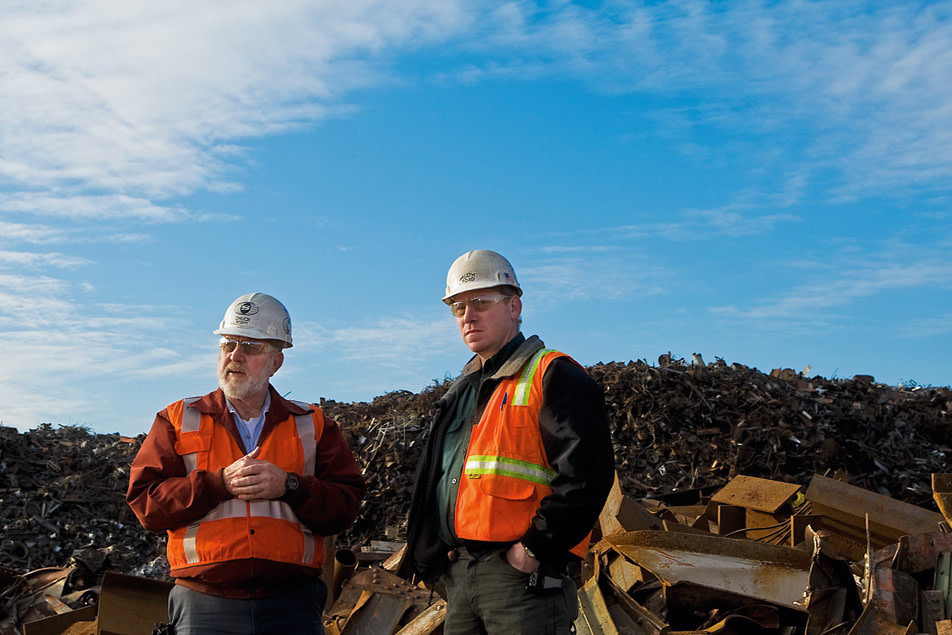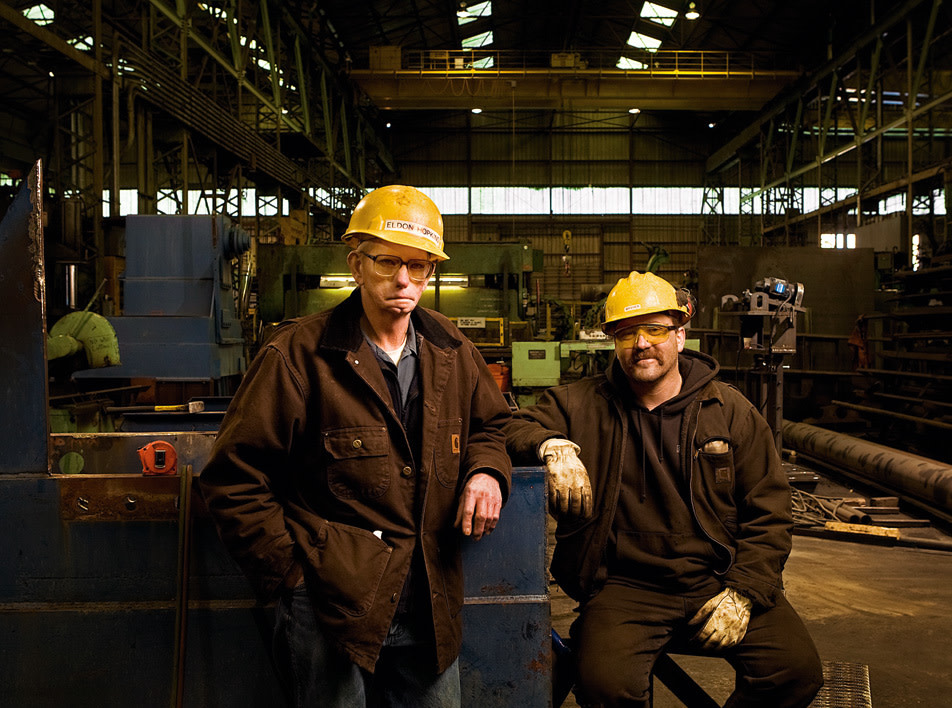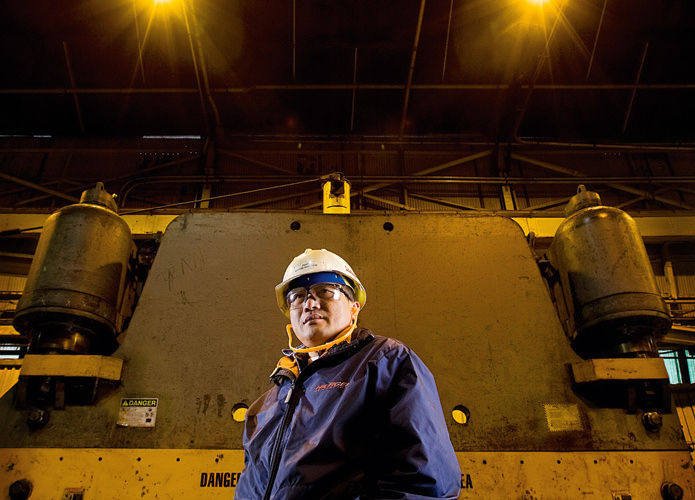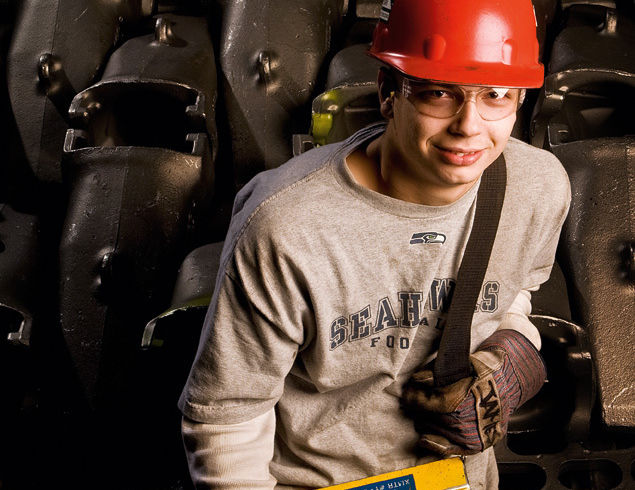Heavy Metal
Tour Portland’s metalworking companies and you’ll find factory yards literally shuddering with roaring engines. Elephantine cranes throw around junked cars as casually as a child tosses a toy, and massive dump trucks loaded with tons of jagged, rusted steel scrap rumble past on tires taller than a man. Welders wearing masks and fireproof coats burn imperfections off of freshly cast backhoe teeth. Day shift, swing shift, graveyard…the production never stops.
Portland’s Harbor Industrial District—6,000 acres that hug both banks of the Willamette River for miles north of the Fremont Bridge—covers roughly 24 times more ground than downtown. One out of every nine jobs in the Portland/Vancouver area is either located here or supported by work that is done here. Yet few urbanites ever catch more than a fleeting glimpse of this world. For most people, it passes in a blur of tanks and pipes and smokestacks while they’re driving Highway 30 en route to Sauvie Island.
Although Portland has largely recast itself as a haven for the creative class, it wasn’t so long ago that thousands of young job-seekers moved here to labor on the waterfront. Out of the heyday of World War II shipbuilding sprang a variety of small and medium-sized industrial businesses that weathered hard times, then drifted off the city’s radar.
The cultural invisibility of the industry poses a critical problem for the 240-odd factories still operating in the district. Talk to the human resources managers for these companies, and they’ll tell you that as the blue collar workforce ages, it’s becoming increasingly difficult to find young apprentices who have the skills—and the will—required to do these jobs.
Still, more than a few blue collar veterans would no sooner cross a union picket line than exchange the hard life of the factory floor for a cushy office cubicle. We dispatched photographer Daniel Root to metalworking companies Schnitzer Steel Industries, Northwest Pipe, Gunderson and Esco Corporation to document the faces—both weathered and fresh—of the people who pour, polish and pound the steel that continues to define the muscle of Portland’s industrial waterfront.

Image: Daniel Root,Daniel Root
SCRAPYARD DYNASTY
Six members of the Ford family work among the scrap summits of Schnitzer Steel Industries: 64-year-old Chuck Ford (left) started in 1964, and as the plant’s longest-tenured employee, he serves as logistics guru, safety watchdog and all-around answer man.
“Steel has no forgiveness,” Ford says. “If you make a mistake, it’s going to hurt you.” But steel’s also been good to Ford. So good, he’s recruited nearly his entire family to Schnitzer, including his 38-year-old son Heath (right), who joined his dad on the scrap piles in 1987 and now oversees the company’s steel shredder. The other Fords focus on crane operation, yard management and cleanup. Heath’s 15-year-old son, Charley, will likely become the next Ford to punch the Schnitzer clock. “He’s got his grandpa’s love of equipment,” Chuck says. Like most old-timers at the city’s heavy-industry firms, Chuck bemoans the sense of entitlement some of today’s applicants bring to the job. “They don’t feel they owe it to the company to do an honest day’s work,” he says. “They think that we owe them something for being here. In just a few days, you can tell when you’ve found a good one.” Someone who’s exceptionally rare these day: a lifer.

Image: Daniel Root,Daniel Root
WORKER PIPELINE
When looking for new talent, managers at Northwest Pipe once counted on a steady stream of students from regional community colleges, but lately, this pool seems to have evaporated. Interest in technical welding has waned, says Northwest Pipe fabricator David Brieher (right), even though the average worker in his position earns close to $50,000 a year. “The way I look at it, the people who don’t get into it? It’s better for me,” shrugs Brieher, 41, who has been with the company since the day he completed Portland Community College’s welding trade school in 1996.
The tradesman says he’s fortunate to be mentored by Eldon Hopkins (left), 65, a veteran welder and equipment designer. Together they build, install and rebuild machinery, with Hopkins serving as designer (armed only with pencil, graph paper and 40 years of experience). “Every day, it’s an education,” says Brieher. “Eldon shows me things he built 30 years ago, and they’re still running.”

Image: Daniel Root
UNDERGROUND RAILROAD
To compensate for a dearth of young applicants from local high schools and community colleges, Gunderson has tapped the city’s growing immigrant labor pool. To help workers learn English, the company employs a language specialist who last counted 22 dialects—including Ukranian, Pacific Islander and various African tongues—spoken on the company’s factory floor.
Khiem Nguyen, 46, escaped Vietnam’s communist regime on a 30-foot-long boat in 1980. He started in Gunderson’s plate shop in 1986, stacking 40-pound steel sheets by hand while living out of his car. Within five years he was promoted to floor manager, and again in 1998 to shop foreman. He now oversees 22 workers who fabricate assorted parts that are welded to the cars. “Whatever it takes, I will do it,” says Nguyen. “It doesn’t matter if it’s 8, 12 or 16 hours.” Nguyen hears a similar refrain from other immigrant coworkers at Gunderson. “Most people here come from a third world country, where they have to work hard for a living, so they already have that built into themselves,” he says.

Image: Daniel Root
FORGING NEW JOBS
Take a walk on the factory floor in the foundry at Esco Corporation and you’ll notice that tenure is measured in decades. That’s because every worker’s hardhat bears a sticker that documents the number of years employed. Plant manager Paul Pope has put in 36 years. But even Pope’s a newbie to manufacturing manager Jerry Bailey, who first punched the clock at Esco in 1961.
And James Hubbard?
“I’m an infant in this company,” says the 22-year-old apprentice, who started in May 2006 as a “flogger,” breaking mining-scoop teeth freshly cast from steel (pictured behind him) from their molds with a pneumatic hammer.
“There’s a lot of room for me to grow, and that’s what brings me here every day.”
Hubbard, who started at $12.50 an hour, doesn’t understand the disdain he hears from former classmates who won’t even consider working industrial jobs. Not when he’s on the fast track to become a shop foreman, a position that fetches as much as $50,000 a year.
“I’m a lifer,” he boasts. “This is where I’ll stay until they tell me to get out of here.”
After all, he’s engaged, and he has to provide for Ethan, his 11-month-old son. Because who knows? In another 18 years Hubbard will be the old-timer, and his son might be the infant on the Esco floor.




